Mobile Fall Protection: Systems, Components, Best Fit Applications
How can I protect my workers at height without installing permanent systems? Mobile fall protection systems are becoming increasingly popular because of their versatility and relative ease of setup, and they could be the right fit for your company.
Fall protection systems come in many shapes and sizes, based on the end-user’s needs. But when your company doesn’t need permanent engineered systems installed to protect your workers, what options do you have?
Mazzella FHS Fall Protection Specialists have discovered mobile fall protection systems are increasing in popularity because these units are versatile and relatively easy to set up.
In most cases, mobile fall protection systems connect to the back of a heavy-duty truck and are trailered onto job sites. They are set up onsite, and then, can be folded up, reconnected to the trailer hitch and taken to another job site.
In this article, you’ll learn:
- What mobile fall protection is
- What the difference is between fall restraint and fall arrest
- Why mobile fall protection is so important
- What type of mobile fall protection systems exist
- What are best and bad fit applications for mobile fall protection systems
- Unique components/characteristics for mobile fall protection systems
- What training is required to use mobile fall protection systems
- Understanding mobile fall protection before buying a system
What Is Mobile Fall Protection?
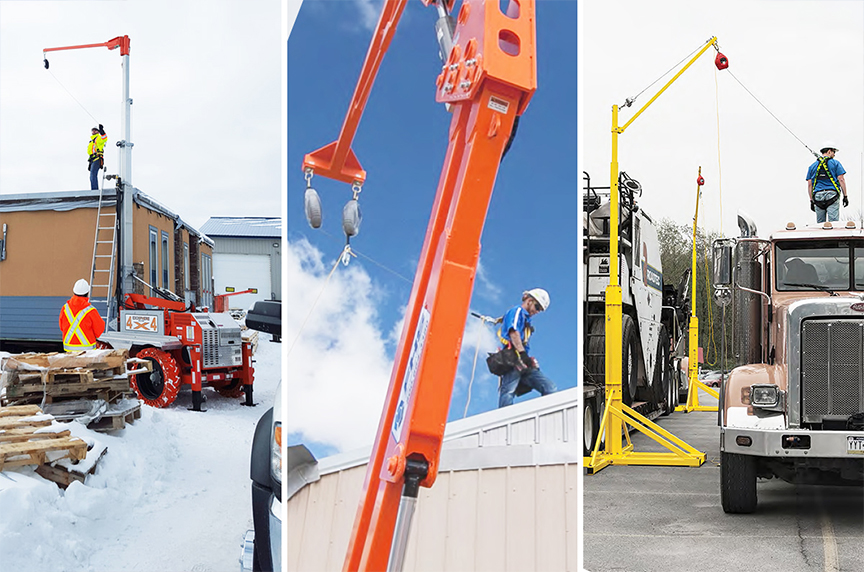
Mobile fall protection is the “sky hook.” That’s what it’s sometimes referred to in the industry. It’s anywhere you don’t have a tie-off point overhead.
Mobile fall protection comes into play because it can be moved from site to site. There are hundreds of different systems available on the market that our specialists find better than others, but it’s just a way to bring fall protection to the work area.
Mobile fall protection is a type of system, whether that’s restraint or arrest, that prevents workers who fall from contacting the ground.
Fall Arrest vs. Fall Restraint
Arresting a Fall
Fall arrest is used when you have a hazard while you’re climbing, or working at heights on top of something. If you could slip, trip or fall off of something, no matter what it is, if it’s a truck, an airplane, a tank, or a staircase, the fall arrest system is in place to stop you from falling.
Example: If you have a leading edge of a roof, and you don’t want the worker to go over the edge of the roof, you would apply a fall protection system that’s 8’ back, and you would allow for the use of a 6’ lanyard.
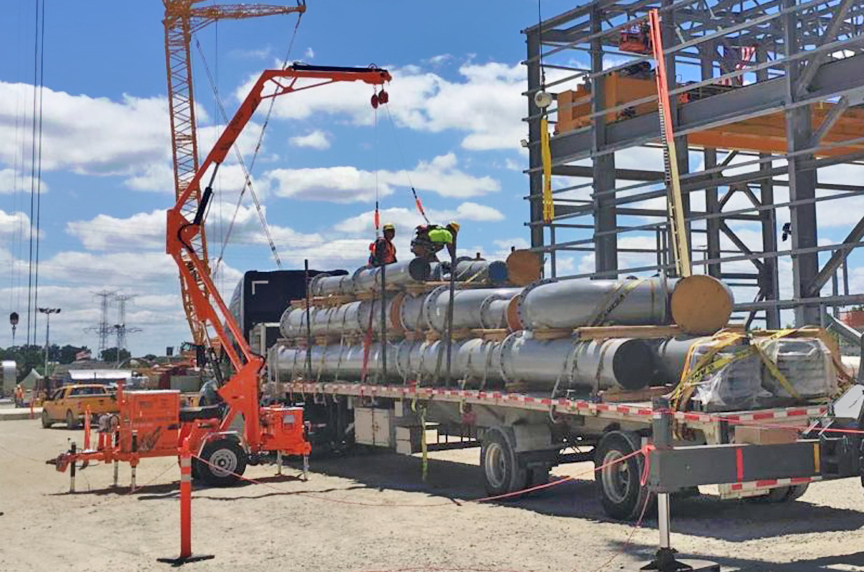
Restraining a Fall
Fall restraint systems are designed to make sure there’s no way workers can get to or fall over the edge of the roof. These systems will keep workers restrained instead of giving them enough length to go over the edge of the roof and needing to have a fall arrested.
Why Is Mobile Fall Protection so Important?
Mobile fall protection is important because there are hundreds of applications at construction sites across the country happening right now with no overhead structure. There’s physically no tie-off point for workers.
Mobile fall protection systems keep workers safe while they’re climbing. You move this equipment into place, and it allows a tie-off point for one to multiple workers depending on which system you selected.
Types of Mobile Fall Protection Systems
The Grabber
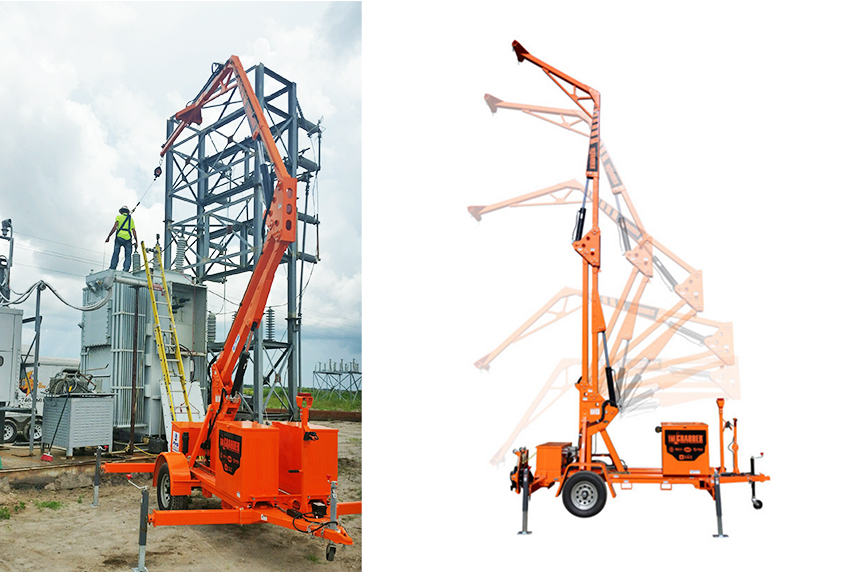
There are systems on wheels, like The Grabber from Malta Dynamics.
Our fall protection specialists have found that The Grabber is probably the most sought-after piece of mobile equipment currently on the market. It’s a wheeled unit with a mast that extends up to 34’ of height. With the different types of Grabber systems available for end-users, between one and five workers can be tied off to the same device at the same time.
Forklift Pocketed Systems
Forklift Pocketed Systems are moved around with lulls on outdoor applications, or even some indoor applications where they use these forklift pocket bases filled with concrete to act as counterbalance weights.
Also, there are engineered masts from between 10’ and 40’ high depending on your application. Whatever you need it to fit, the masts are customizable.
Truck-Mounted Systems
Just as it sounds, these compact systems simply attach to your truck hitch.
These systems use your truck as the counterweight needed to meet the guidelines of having 1,800 lbs. engineered tie-off or 5,000 lbs. non-engineered tie-off points. The system comes out of the hitch and goes straight up, and can raise to heights between 8’ and 14’ tall.
The truck-mounted system has a multi-piece mast that folds up as you need it. You simply plug the system into an adapter, lock it, and then, those workers are able to use that system as their tie-off point.
The Exosphere
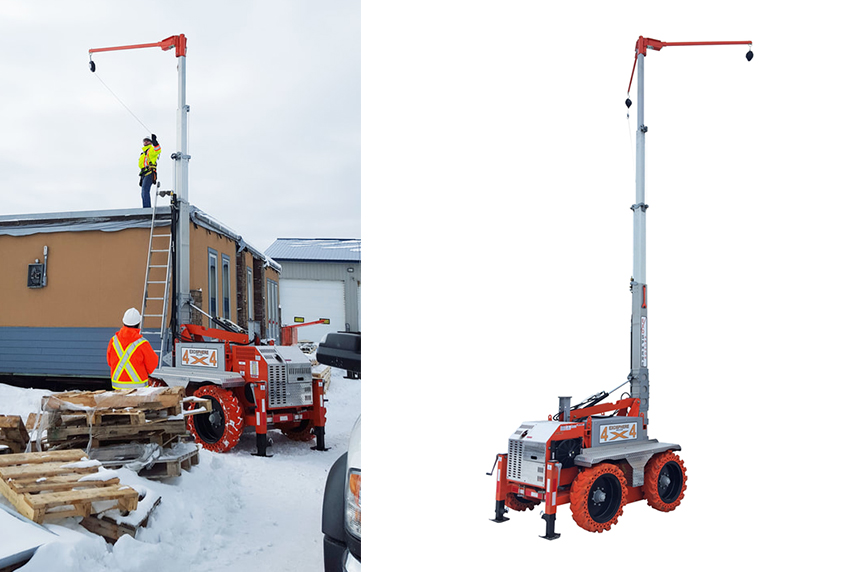
Tuff Built Products offers this four-wheel drive model, which is a good option when you’re working in adverse weather or rough-terrain conditions. It has tractor-like tires, and is driven by remote control. The end-user can move it into position with their remote, and then, extend the mast up to 40’ and have a tie-off point for two workers.
With its rotating mast, you’ll be able to park it next to where the workers need that tie-off point more overhead. It’s important to remember to keep the tie-off point directly above your workers whenever possible.
Also, The Exosphere features two 8’ davit arms that come off the mast, and the D-rings on the end of the system provide tie-off points for two workers.
The Exosphere is designed for:
- Rough terrain
- Gravel rocks
- Snowy environments
- Other environmental reasons for not using a trailered system
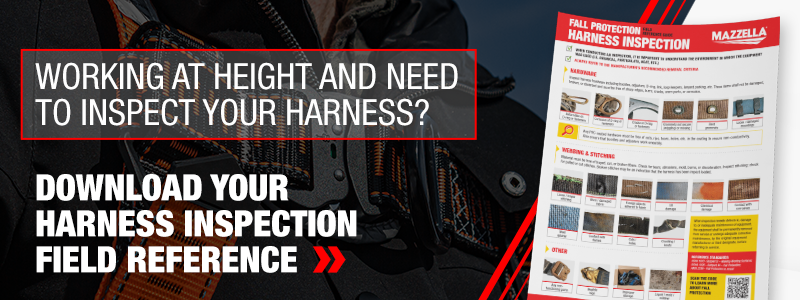
Best Fit Applications for Mobile Fall Protection Systems
Mobile fall protection systems are good fits in indoor and outdoor environments, especially in manufacturing facilities where workers have to climb on top of products being built.
Examples include:
- Airplanes
- Tanks
- Cars
- Walkways that don’t have adequate guardrail protection
- Outdoor chemical plants
- Grain silo facilities
- RV manufacturing/service centers
Bad Fit Applications for Mobile Fall Protection Systems
Sometimes, mobile fall protection systems aren’t the right answer for your company. That can be discovered by doing a job site analysis.
Uneven ground surfaces or areas where there’s not a big enough footprint to move a mobile system into place are two of the major drawbacks to mobile fall protection systems.
There are new smaller systems in production that you can move around with a forklift. However, most of the mobile systems on the market right now require a heavy-duty truck to move in and out of position.
The Grabber isn’t a rough-terrain system, and instead, requires a flat asphalt or concrete parking lot surface.
Unique Components/Characteristics for Mobile Fall Protection Systems
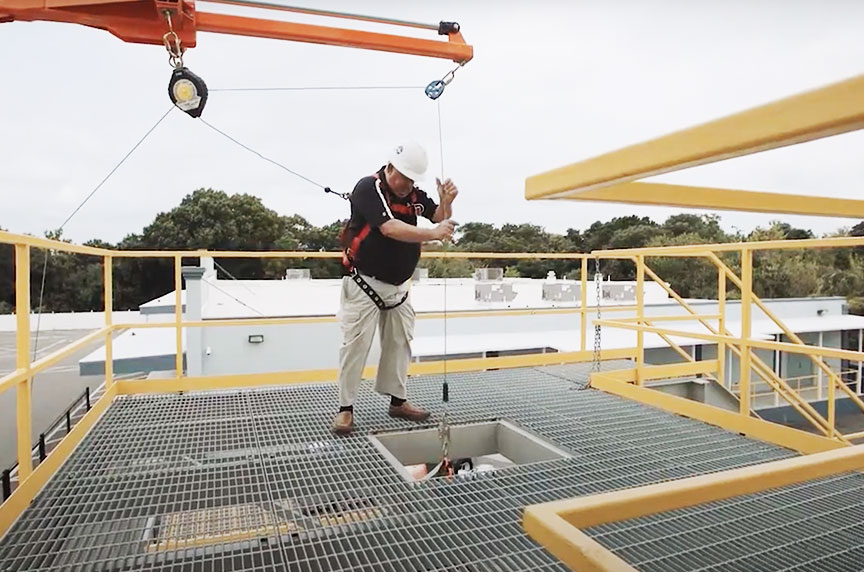
Mobile fall protection systems are unique simply because of their available reach.
The Grabber allows you to go up to 34’ with a mast on a trailer-mounted system. That’s going to be adequate for several types of structures, including electrical substations. Every month, those substations need to be serviced and people have to go on top of the structures to make sure everything is in working order.
There’s a hydraulic boom that puts the tie-off point over top of the workers.
Example: If your workers can’t back up to what they’re working on, that outrigger is key because it can come out another 5’. It extends and allows you to get a tie-off point further away from the unit than other systems.
The Exosphere is 40’, but that’s for two workers. Also, The Exosphere has davit arms. You can go with 6’ or 8’ davit arms, and take them out when you’re done using the system. You put them back in as they’re needed.
Highway-Rated
The Grabber and The Exosphere are highway-rated, and approved by the Department of Transportation (DOT) for doing 65 MPH when travelling from one site to another.
Because of their weight, these systems are equipped with:
- Lights
- Trailer lights
- Trailer brakes
Mazzella FHS Fall Protection Specialists have found utility company work is where these systems have been most convenient. A small fleet of mobile fall protection devices make working at height safer during storm damage repairs where there are no available overhead tie-off points.
What Training Is Required to Use Mobile Fall Protection Systems?
The simple answer is not much.
They’re sophisticated and complicated in a sense of what they’re doing. Sometimes, the work being performed using these systems is, but not much training is needed to operate them.
If you’re a competent person in fall protection, you can utilize these systems with just a quick training course. Also, end-users can go online and watch video demonstrations of how to set up their system.
Mazzella FHS offers training on these systems as well. Whether it’s via Zoom, or if we sell a new unit and come on site, we train the workers that are going to use the system, and anyone else that’s interested in seeing how it works.
Encouraging Mobile Fall Protection System Usage
If mobile fall protection is a difficult process, a worker might be tempted to say, “Hey, I can go up there for two minutes and get this done without putting on any safety gear. It’s no big deal.”
We often see that in the field a lot, and it’s a dangerous way to operate because you’re one slip away from not being able to come back to work tomorrow, or live life with your family. Unfortunately, it happens to a lot of workers.
These manufacturers work hard to make the systems easy for end-users to utilize.
Understanding Mobile Fall Protection Before Buying a System
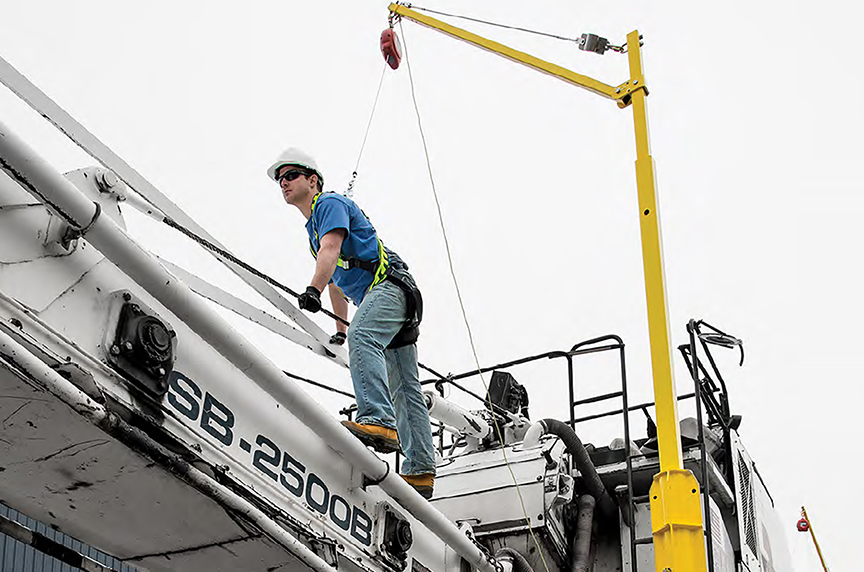
First and foremost, make sure it’s a good fit, and understand how large these systems are.
Tight-quarter spacing is one thing we experience a lot when visiting work sites. Within minutes, fall protection specialists know, “Hey, if you don’t have 8’ of width and 12’ of length for us to maneuver into with The Grabber or Exosphere, this wouldn’t be the best fit for you.
Height is another concern.
People working on a 10-story building have called our experts to see if The Grabber would work for them. With that system, 34’ is going to be your maximum height reach, and it’s 40’ with The Exosphere.
While these systems fit the needs of many applications, there are some situations where it’s just not the right fit.
Environmental Conditions Affecting Usage
The Grabber is a heavy unit that does not use mud-terrain tires. If you’re going into snowy conditions or even in a real sandy environment, it’s going to be tough to tow that unit where it’s needed.
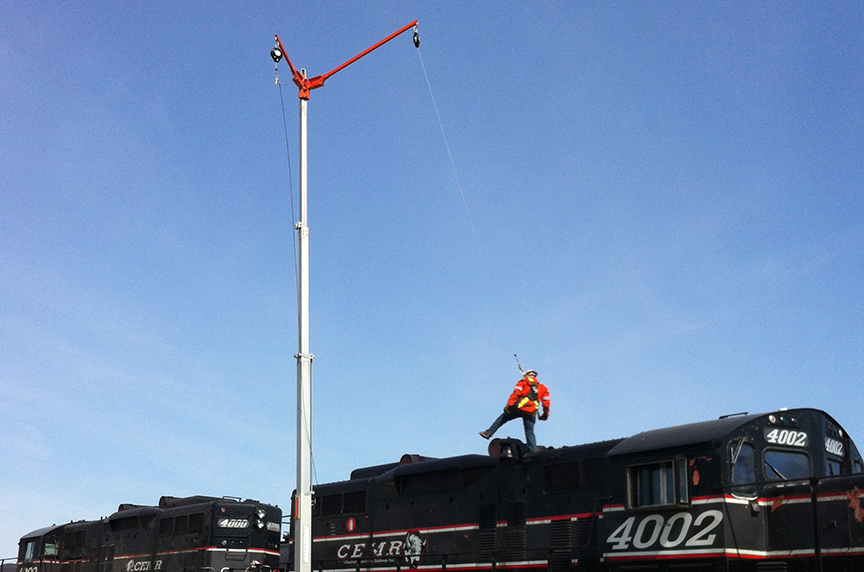
Questions End-Users Should Ask/Answer
How many workers are we looking to protect at one time?
That lets Mazzella FHS Fall Protection Specialists know:
- Do you need a 1240 series Grabber from Malta Dynamics that can protect two workers?
- Is a 1250 series Grabber from Malta Dynamics that can have three workers a better fit?
- Do you need a 1260 series Grabber from Malta Dynamics that can have up to five workers?
What’s your lowest overhead obstruction?
- Can you fully boom this system in your facility?
There’s been a lot of testing in the last year that actually proves the mast doesn’t have to be fully extended to use the equipment effectively. However, it’s still good to know what your lowest obstruction is because it allows us to better help you maneuver the system inside your facility.
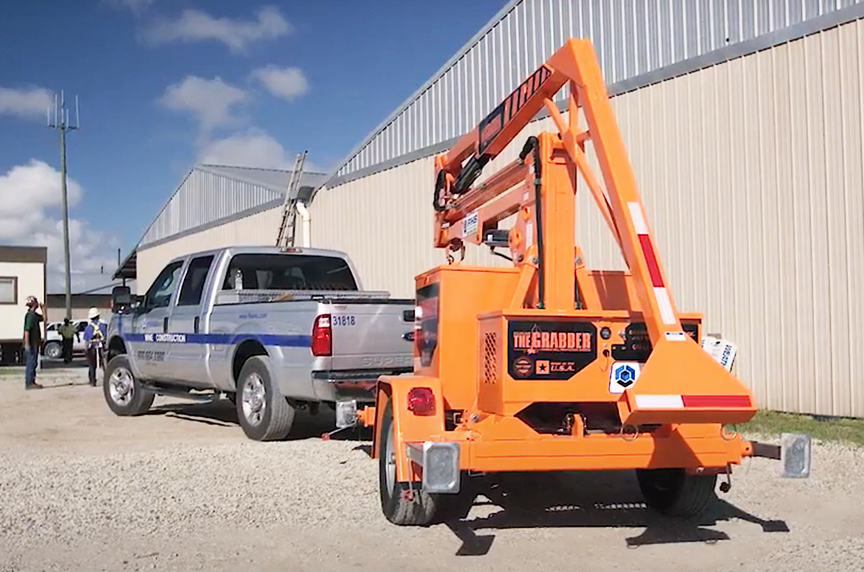
How close can you get to what you’re working on?
Example: While working in Alabama, our experts have seen moats in place around substations to catch water in the event of severe flooding. That created an issue for us because ramps were needed to allow The Grabber to go over the moat and get closer to their work.
Are you trying to walk the full length of a flatbed trailer that’s 52’ long?
The Grabber would be good while positioned in the middle of the trailer, but it’s not going to cover that entire flatbed or that entire 53’ deck.
*** Photos go a long way for Mazzella FHS Fall Protection Specialists when providing proposals to their customers. If end-users can show us the area they’re working in, it really helps determine the best system for their workers.
Removal from Service
Like all fall protection measures, if a fall, and not just like a slip, occurs, you need to remove your mobile system from service until a third-party company like Mazzella FHS comes in and inspects that unit.
What our specialists will be looking for is:
- Any fractures in the metal
- Any damage that was caused to the mast by the fall
The self-retracting lanyard (SRL) that’s used with the system, as well as the body harness, should be pulled from service.
All body harnesses are good for one fall. They have breakaway stitching to help absorb that fall shock, or that deceleration factor that kicks in. The SRL needs to be fully inspected.
Including D-rings and the mast, the system needs an overall inspection to the manufacturer’s recommendations.
Financial Investment for Companies
Are mobile fall protection systems more cost-effective than other fall protection equipment?
Example: If our experts did a site visit with your company, and found you had 20 areas where workers could be climbing on inside your facility. We could propose, depending on the application, either 20 separate lifeline systems or separate track systems.
These rigid lifelines with an enclosed track would require multiple systems to cover all those areas where a mobile device, as long as it can maneuver around your facility, can cover multiple places. It’s not going to cover them all, more than likely, but with one cost, it’s more financially effective to have a mobile fall protection system.
If working at height is something you’re doing every day, and you can install a permanent system, that’s ideal. However, if you’re just climbing once in a while in an area where you’ve got to go in and check on something or perform work at height, a mobile system is, for sure, the way to go.
The mobile systems offer significant cost savings instead of installing multiple systems.
Wrapping It Up
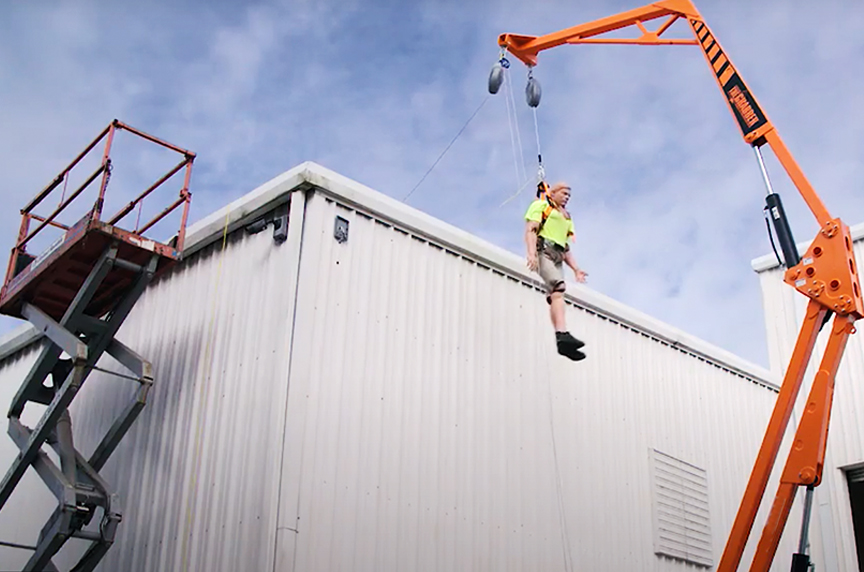
Falls are the leading cause of death in the construction injury.
Even falls from as little as 4’ to 6’ can cause serious injury/death to your workers. These injuries/fatalities not only harm the individuals who experience them, but cost U.S. businesses more than $125 billion a year, according to OSHA Publication 2056.
After reading this article, we hope you have a better understanding of how mobile fall protection systems:
- Give end-users fall protection solutions when no overhead tie-off points exist
- Maneuver in tight spaces
- Handle rough and flat terrains
- Minimize the need for installation of permanent lifeline systems
- Ease of use
- Are highway-rated for convenient transport to and from job sites
Also, we hope you use that knowledge to evaluate your current operations and see where improvements can be made in fall protection.
Mobile fall protection systems aren’t a perfect fit for every job, but they’re one solution to a major problem.
Remember, Mazzella FHS is here to help your company address any safety concerns and needs.
Call us at 800.362.4601 or click here if you need solutions or training for your workers at height.
<!–[if lte IE 8]><![endif]–>
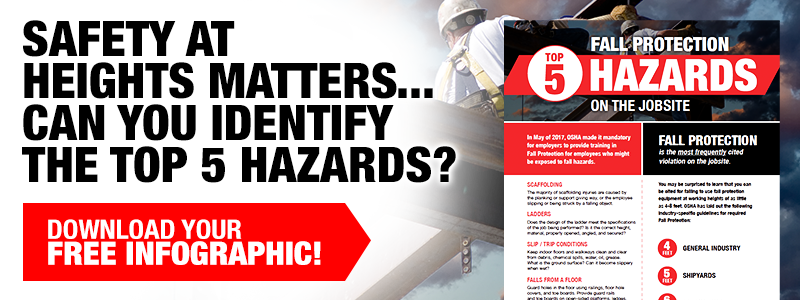 hbspt.cta.load(3336966, ‘5acd72ed-bdec-4e1e-9e59-e75e14aea4db’, {“region”:”na1″});
hbspt.cta.load(3336966, ‘5acd72ed-bdec-4e1e-9e59-e75e14aea4db’, {“region”:”na1″});


❯ Fall Protection
We are a leading supplier and installer of engineered fall protection systems in the U.S., as well as a distributor of soft goods like harnesses, lanyards, self-retracting lifelines, scaffolding, and netting.
Copyright 2021. Mazzella Companies.
